If you’ve been to Japan, you’ve probably seen a lot of plastic food models in front of restaurants like this.

They are called ‘shokuhin sampuru’ or ‘Fake Food Sample’ and have been part of the Japanese economy and food culture for almost a hundred years.
There is some controversy surrounding the origin story of these strangely realistic food models. The best-known story probably dates back to 1917, when Japanese businessman Takizo Iwasaki created a realistic model of an omelet using wax. When he showed it to his wife, she couldn’t tell the difference between it and the real one. Soon, Iwasaki made models and sold them to restaurants and grocery stores as examples of the food on sale [1,2].
Nowadays, these models are often displayed on the street, in front of eateries and restaurants, to describe the dishes available inside in detail. In this way, restaurants and eateries can make their dishes realistic; diners have a more intuitive view of the food and make it easier to choose
Especially for foreign visitors, since not everyone can understand Japanese, having these models helps convey what the restaurant offers.
Usually, they are carefully handmade from resin, turpentine, or similar materials by artisans. These replicas, from simple to sophisticated, every little detail is meticulously designed. Therefore, the cost of ordering these models is very expensive. Simple models have been priced from about 3,000 yen (~23 USD). The price will gradually increase depending on each model’s complexity and details.

“Fake food” also contains models of drinks or desserts. Here is a video of some samples around Japan:
References
[1] https://www.today.com/food/trends/sampuru-japanese-art-fake-food-rcna26990
[2] https://en.wikipedia.org/wiki/Food_model



